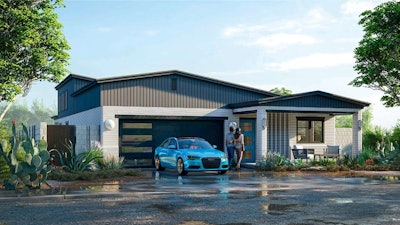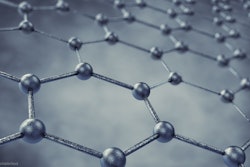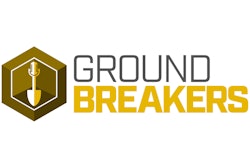
The first home funded by a public-private grant broke ground in early June 2021. Headed up by a 3D printed home construction company Alquist 3D in partnership with the Virginia Center for Housing Research at Virginia Tech., the construction is being done in Richmond, Va., and funded by a $500,000 Innovation Demonstration grant from Virginia Housing. Project:HOMES and the Better Housing Coalition have provided a site, will aid in regulatory compliance such as permits, zoning, and insurance as well as homeownership services.
 Alquist
Alquist
Project Specs:
- 1,550 sq. ft. of space
- Includes three bedrooms, two bathrooms, kitchen island, laundry room, covered front porch (with a swing)
- Target cost: $181,000 for future 3D-printed houses, listed for sale around $210,000 (costs and sales price of this initial prototype will likely be higher)
- Expected to be 50% more energy-efficient than code requires
Through this partnership, the two companies have united to address what they believe is the top need in nearly every rural community: housing. They hope to work together in communities across the U.S. in the development of new single-family, multifamily, mixed-use, and senior living units. But Alquist doesn't stop there. They have invested in research to determine is 3D printing technology can be used for the construction of alternative concrete structures like roads, elevator shafts, and retaining walls.
According to the National Association of Home Builders, "estimates indicate that a $1,000 increase in the median new home price ($346,7571 ) would price 153,967 households out of the market." Unfortunately, construction using lumber at current prices brings its own set of challenges and monetary issues. However, as reported in the June 8 announcement, this expense has risen the price of an average single-family home by almost $36,000—putting new homes out of range for more than 5.5 million families.
Potential Savings
Founded to address this inequity within the housing market, Alquist was founded based on the belief that 3D printing technology could be a potential solution to a lower cost of housing construction. The contractor's 3D printed concrete homes utilize concrete and, reportedly, "estimates suggest provide initial savings of up to 15% per square foot in building costs" as well as saving a significant cost in labor (potentially weeks). Alquist says that a 3D concrete printer's frame can be constructed with two workers (with training) in 12-15 hours. The Richmond project's announcement states that "Alquist will be 3D printing the exterior walls, while building both interior and exterior walls in future homes."
 Alquist
Alquist
Alquist also claims long-terms savings including heating, cooling as well as a potential resistance to tornado and hurricane damage. Standard in all Alquist homes, a proprietary Raspberry Pi-based monitoring system from Virginia will be installed in the Richmond project to track and maintain the indoor environment, helping saving homeowners money with data.
- Indoor environment sensing, including air quality, temperature, humidity, lighting, sound, vibration, flame, and many kinds of gases
- Security and alarm system with motion detection in assigned building spaces
- Emergency management, including smoke and fire detection
- Occupant comfort analysis
- Space utilization analysis
- Energy consumption optimization
"While most 3D printing endeavors focus on urban residential areas and commercial buildings, many of the regions facing the biggest housing challenges exist in rural America. That’s why we partnered with Virginia Housing and Virginia Tech to build homes for people who live outside of the places where most funding for housing programs is spent. These two cutting-edge organizations are breaking barriers and finding new ways to serve their community, and we’re honored to be working hand-in-hand with them."
—Zachary Mannheimer, Founder and CEO of Alquist
The announcement explains that the grant monies weren't only used for the construction of the home, but Alquist was also able to purchase of a BOD2 modular 3D printer from Construction Of Buildings On Demand (COBOD). "The printer runs on a gantry system that is assembled onsite, preventing the need to ship large, pre-built modular pieces to construction zones. The system can be assembled in four hours and disassembled in three hours. The BOD2 can also print on uneven surfaces. It is open-source, allowing a number of materials to be used, including new sustainable materials currently being developed. Even more remarkable, the system can be operated by just two trained construction workers."
According to Virginia Housing, the cost of construction of a 3D printed home can be $10 less per square foot than a lumber-built home.
 A rendering of a COBOD 3D concrete printer.Construction Of Buildings On Demand
A rendering of a COBOD 3D concrete printer.Construction Of Buildings On Demand
Andrew McCoy, Ph.D., and Alquist’s Virginia Tech lead explains that his team was excited to work with a partner like Alquist, "The technology is itself an interesting challenge and its possible impact on housing costs, schedule, and quality are exciting,” says McCoy. “The long- and short-term cost and time savings over ‘standard built' houses continued to reveal themselves throughout the design-build process, and we are excited to pass those savings along to the family that eventually calls this amazing project ‘home’.”
 Alquist
Alquist
Virginia Housing is working with housing experts and community partners for the Richmond 3D home. Susan Dewey, CEO of Virginia Housing says, “Our latest project builds off of recent innovative approaches we’ve explored, including modular and factory-built homes, and it reflects our longstanding commitment to making homes affordable for all Virginians. The lack of affordable housing impacts every family and every community, and we won’t stop until every Virginian has a safe, affordable place to call home.”
 PERI Group
PERI Group
Meanwhile...
Meanwhile, on the other side of the country, PERI Group - the formwork, scaffolding, and engineering company - constructed "the first residential building in the USA" (announced on June 16, 2021) in Tempe, Ariz. They claim it's one of the first 3D housing projects to date that passed all regulatory approval processes.
Project Details
Single Story Detached House
1,720 sq. ft. (160 m2) of living space
Two week printing time
According to current plans, the house will be ready for occupancy in August / September 2021 - a considerably impressive timeline compared to a standard construction ground-breaking to completion. Much like Virginia, PERI's Arizona construction will also benefit the community. The company partnered with the regional Habitat for Humanity organization.
“The use of 3D printing technology is a tremendous opportunity for Habitat for Humanity”, says Jason Barlow, President and CEO of Habitat for Humanity Central Arizona. “The current housing problems in Arizona convincingly demonstrate the need for affordable homeownership. To solve the problems in a sustainable way, we need new ideas and methods to build adequate, affordable, and more energy-efficient houses at lower costs, in less time, and with less material consumption. The Tempe project is a forward-looking step for us.”
While one of the early adopters for the U.S., the house is not a first for PERI as they have completed a number of projects in Europe. Thomas Imbacher, board member for Innovation and Marketing at the PERI Group explains that they've worked on the first houses in Germany such as the printings in Beckum (North Rhine-Westphalia) and Wallenhausen (Bavaria). He sees this as the company "taking the next step in the market development of 3D printing technology."
 PERI Group
PERI Group
In 2018, PERI acquired a stake in COBOD - the Danish manufacturer of the "BOD" and the 'BOD2" 3D printers. PERI used the BOD2 in the construction of both the Germany projects as well as this latest home in Arizona.
The June 16 release describes the BOD2 system that has a print head that moves about three axes on a securely installed metallic frame. The benefit here is that the printer can move along its frame to any position within the construction and only needs to be calibrated once. This saves time and cuts costs. During the printing process, the printer takes into account the pipes and connections for water, electricity, etc. that are to be laid at a later time. The BOD2 has been certified in such a way that it is possible to carry out work within the printing area while printing is in progress. This means that manual work, such as the installation of empty pipes and connections, can be easily integrated into the printing process.
 PERI Group
PERI Group
Will this mentality spark a new wave of cost-effective and environmentally-friendly home construction? Only time will tell. The list of 3D concrete contractors in the U.S. is short, however, contractors like Alquist and groups like PERI have already set their designs towards rural and residential construction.
Keep an eye out in these next years. Given the potential of cost savings, time, and creativity that 3D concrete printing might provide, there will likely be plans for many more projects like these and others around the country.



















